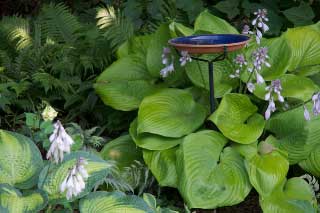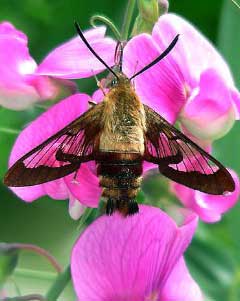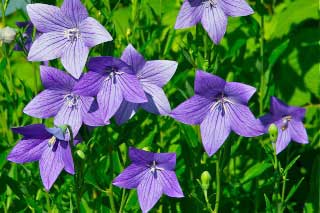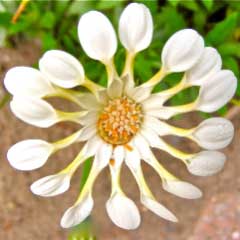Hummer or moth? Summer of mysteries
Donald McClure | Jul 20, 2010 | Comments 4
Last week a neighbour reported the sighting of an unusual hummingbird in his garden. He described it as a basic brown colour with a lighter band in evidence. My first inclination is that he had spotted a humming-bird moth, which roughly meets his description and has the fast humming wing motion to carry off the impersonation. Next door we have had visits from these unusual moths on bright sunny days for the last two years.
He insisted that this was a humming bird. Since the only hummer that normally visits these parts is the familiar ruby-throated what else could it be? In a year in which Terry Sprague has reported some unusual visitors from the south (yellow-nosed albatross
and black-bellied whistling-duck this week) could it be another appearance of a rufous hummingbird in Ontario? These West coast natives were identified in Stratford, Niagara Falls and London a while ago. Hopefully the visitor will show up again and pose for a photograph.
Incidentally thank you to Linda Tuck Chapman and Tom Ashbourne for their reported sighting of a rare summer tanager in the County. I passed their message along to Terry Sprague for his expert analysis.
Gardeners bowled over by this summer’s heat and humidity can quickly understand the devastating effect the hot, clammy weather has had on wildlife. To ease the lot of our stressed garden visitors it is important for all homeowners to maintain a clean bird bath filled with fresh water and monitored daily through these stifling months. Birds tend to be a bit careless in their hygiene so I hide a little scrub brush near by to aid in the clean-up. We keep four in operation and it takes a bit of work. But it does have a payoff.

Debbie Marginson whose vigourous weeding has kept the jungle away from our flower beds this summer again, reported this morning that she actually witnessed two male and one female cardinals and a pair of orioles sharing one of our bird baths. Anyone who has experienced the sheer joy and abandon of a bird taking a splash bath can realize how much pleasure these important cooling and drinking stations are to the avian community.
Also on the list of of users is a growing army of hornets who drift in, often landing on the surface of the water, tanking up and hauling it back to the hive.
Garden tip of the week: Keep those wonderful balloon flowers blooming and the plants looking clean and pristine by pinching off the depleted blossoms. Spent blossoms later turn into seed pods. By taking them away, the plant is stimulated to keep on producing. Works for a number of other plants also like foxglove.
New introduction to our garden this year is the Osteospermum hybrid Soprano Vanilla Ice. Planted in full sun, this award-winner grows about a foot tall and a foot wide and puts out larger-than-toony sized white flowers which look like a circular cluster of spoons. Get a green background behind the flowers and they are little shy of spectacular.
Another plant I found intriguing is the five foot high pink culver weed, with its spires of light violet-blue which seems to drive the pollinators crazy. Worth a look for that ideal background flower.
Rose of Sharon was in bloom this week — another plant slightly ahead of schedule.
Filed Under: Donald McClure • Uncategorized
About the Author: He can tickle your funny bone or tug at your heart strings. County people may know him as a chronicler of everything that happens (or should happen) in the garden, but his interests stretch across the natural world. His unique sense of observation takes in a wide expanse of living and may even point out some truths about our own condition as managers of the world around us. With Loyalist antecedents in his family tree his roots go deep into the Ontario countryside.


































Chuck Yeager [first man to break the sound barrier] said “a bummble bee; never fly”.
That is so interesting about the hornets! I wondered why they were around my bird bath! Thanks for the tips! I will defintetly buy another one and fill it am and pm!
The mums in my garden are about to flower quite a bit earlier than usual as well!
Always interesting advice Donald!
Donald, really enjoy your blog. Would you mind sending me or posting on your blog, a photo of your Rose of Sharon? When we moved into our home in Carrying Place three years ago, a neighbour told me a small tree on my front lawn was a Rose of Sharon. But it wasn’t, it is actually a Hydrangea tree. (he also told me the climbing vine at the front of the house was a Hops…turns out it is a Wisteria, much to my excitement! It didn’t bloom the first year we were there, but the following two years it has).
More than likely a “hummingbird moth,” a family of sphinx moths that are common to flower gardens, especially in the early evenings, and particularly at this time of the year. We have seen quite a number of Pandorus Sphinx this week. Rufous hummingbirds typically do not show up until November when individuals with flawed programming head east instead of south.